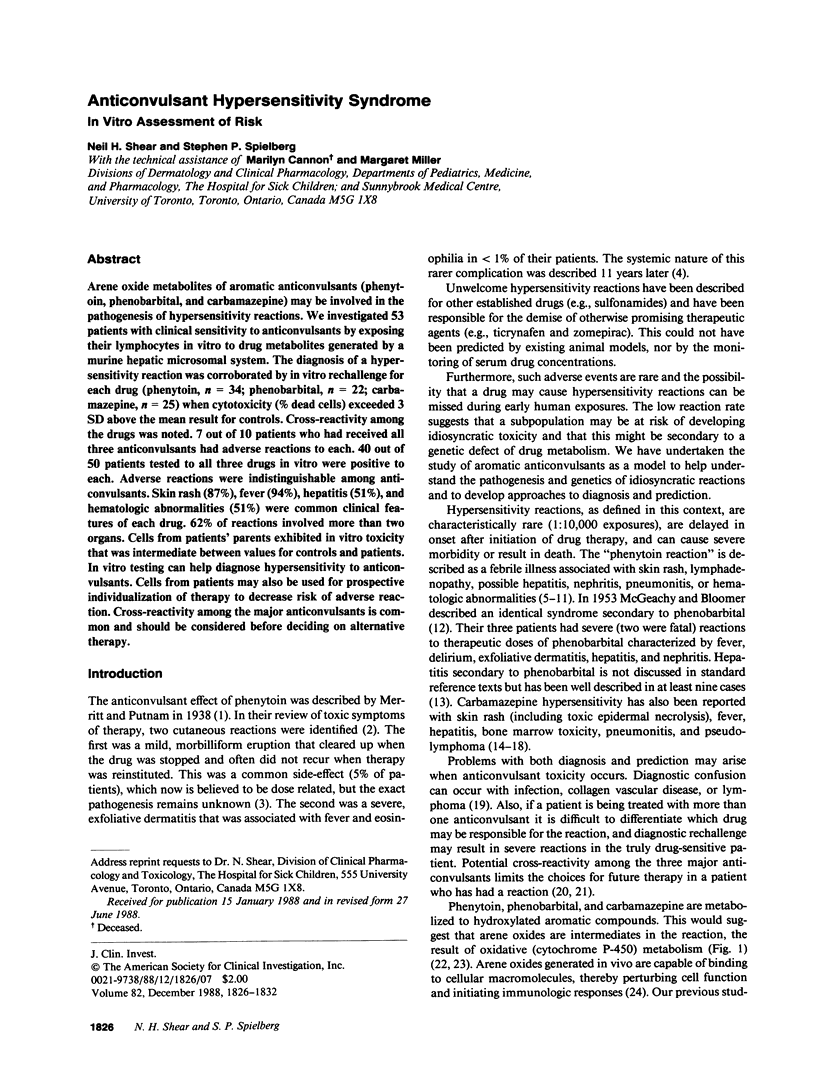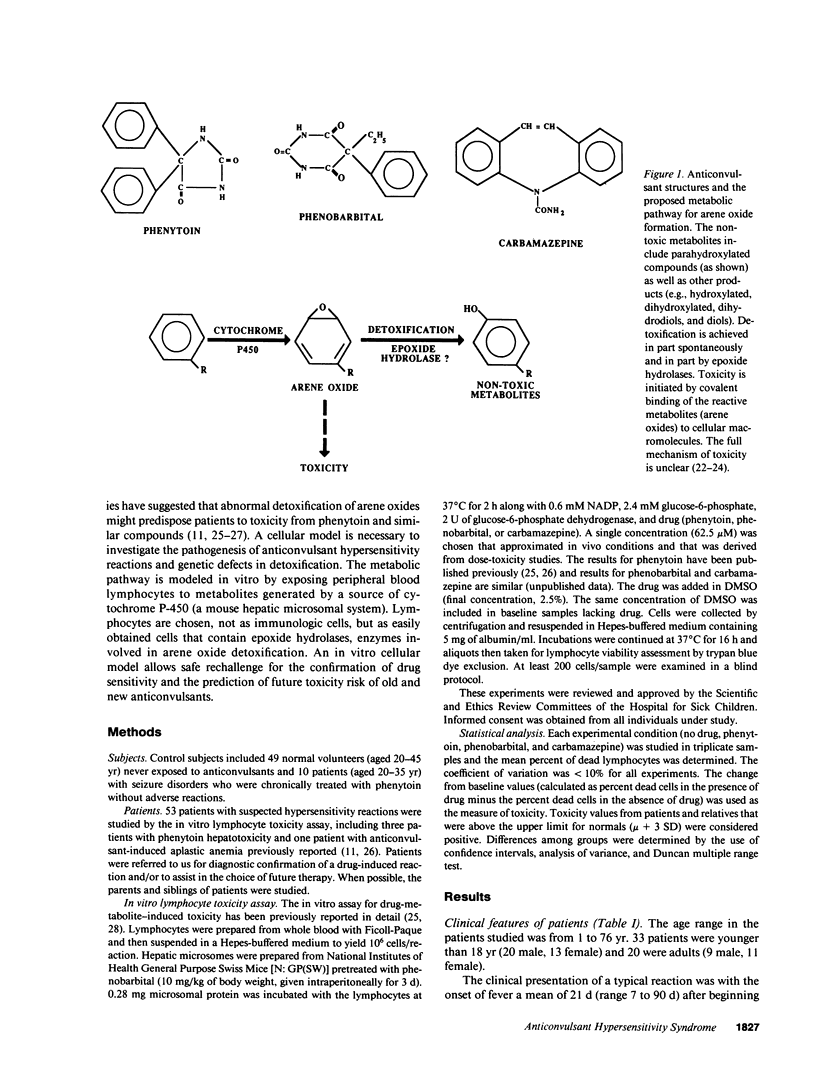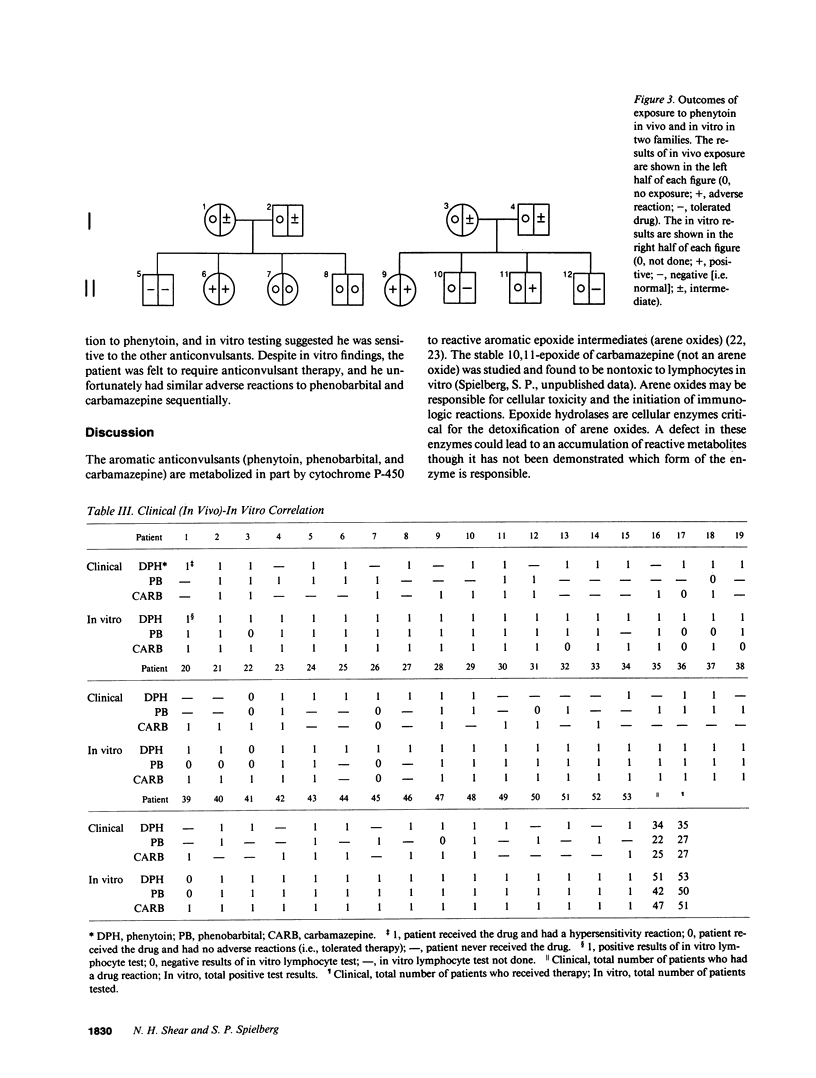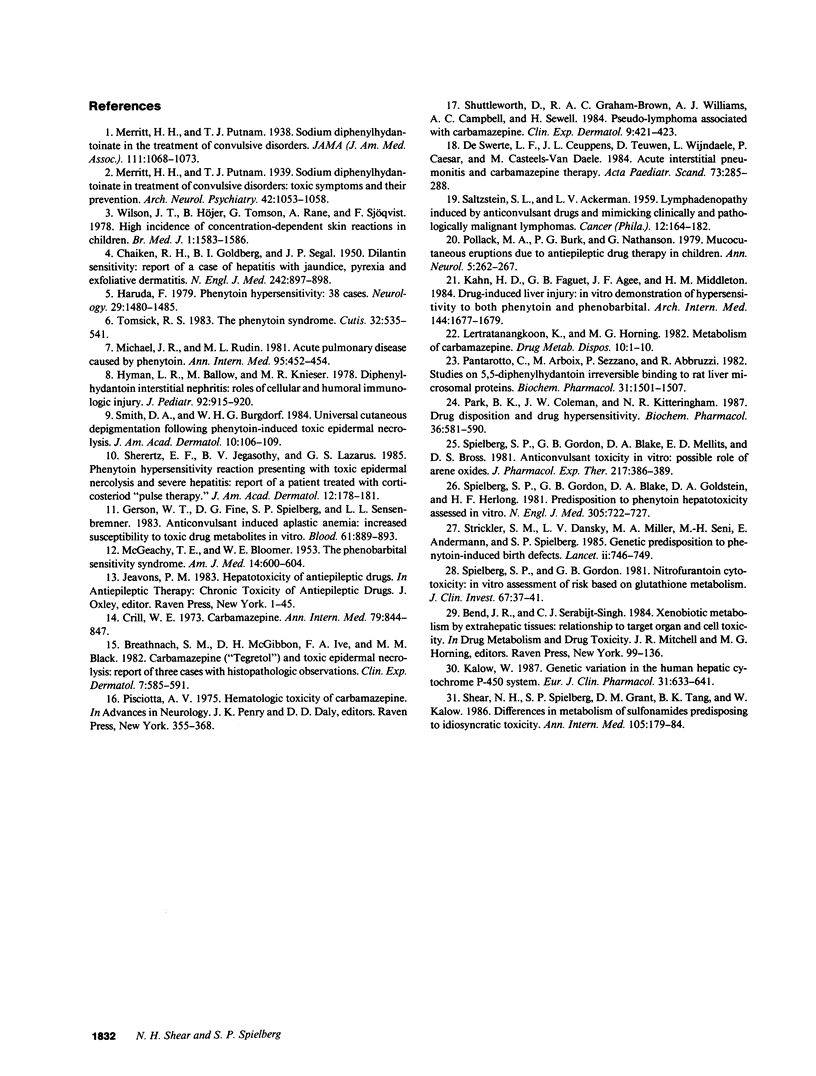Abstract
Arene oxide metabolites of aromatic anticonvulsants (phenytoin, phenobarbital, and carbamazepine) may be involved in the pathogenesis of hypersensitivity reactions. We investigated 53 patients with clinical sensitivity to anticonvulsants by exposing their lymphocytes in vitro to drug metabolites generated by a murine hepatic microsomal system. The diagnosis of a hypersensitivity reaction was corroborated by in vitro rechallenge for each drug (phenytoin, n = 34; phenobarbital, n = 22; carbamazepine, n = 25) when cytotoxicity (% dead cells) exceeded 3 SD above the mean result for controls. Cross-reactivity among the drugs was noted. 7 out of 10 patients who had received all three anticonvulsants had adverse reactions to each. 40 out of 50 patients tested to all three drugs in vitro were positive to each. Adverse reactions were indistinguishable among anti-convulsants. Skin rash (87%), fever (94%), hepatitis (51%), and hematologic abnormalities (51%) were common clinical features of each drug. 62% of reactions involved more than two organs. Cells from patients' parents exhibited in vitro toxicity that was intermediate between values for controls and patients. In vitro testing can help diagnose hypersensitivity to anticonvulsants. Cells from patients may also be used for prospective individualization of therapy to decrease risk of adverse reaction. Cross-reactivity among the major anticonvulsants is common and should be considered before deciding on alternative therapy.
Full text
PDF






Images in this article
Selected References
These references are in PubMed. This may not be the complete list of references from this article.
- Breathnach S. M., McGibbon D. H., Ive F. A., Black M. M. Carbamazepine ('Tegretol') and toxic epidermal necrolysis: report of three cases with histopathological observations. Clin Exp Dermatol. 1982 Nov;7(6):585–591. doi: 10.1111/j.1365-2230.1982.tb02481.x. [DOI] [PubMed] [Google Scholar]
- CHAIKEN B. H., GOLDBERG B. I., SEGAL J. P. Dilantin sensitivity; report of a case of hepatitis with jaundice, pyrexia and exfoliative dermatitis. N Engl J Med. 1950 Jun 8;242(23):897–898. doi: 10.1056/NEJM195006082422304. [DOI] [PubMed] [Google Scholar]
- Crill W. E. Drugs 5 years later: carbamazepine. Ann Intern Med. 1973 Dec;79(6):844–847. doi: 10.7326/0003-4819-79-6-844. [DOI] [PubMed] [Google Scholar]
- De Swert L. F., Ceuppens J. L., Teuwen D., Wijndaele L., Casaer P., Casteels-Van Daele M. Acute interstitial pneumonitis and carbamazepine therapy. Acta Paediatr Scand. 1984 Mar;73(2):285–288. doi: 10.1111/j.1651-2227.1984.tb09948.x. [DOI] [PubMed] [Google Scholar]
- Gerson W. T., Fine D. G., Spielberg S. P., Sensenbrenner L. L. Anticonvulsant-induced aplastic anemia: increased susceptibility to toxic drug metabolites in vitro. Blood. 1983 May;61(5):889–893. [PubMed] [Google Scholar]
- Haruda F. Phenytoin hypersensitivity: 38 cases. Neurology. 1979 Nov;29(11):1480–1485. doi: 10.1212/wnl.29.11.1480. [DOI] [PubMed] [Google Scholar]
- Hyman L. R., Ballow M., Knieser M. R. Diphenylhydantoin interstitial nephritis. Roles of cellular and humoral immunologic injury. J Pediatr. 1978 Jun;92(6):915–920. doi: 10.1016/s0022-3476(78)80360-6. [DOI] [PubMed] [Google Scholar]
- Kahn H. D., Faguet G. B., Agee J. F., Middleton H. M., 3rd Drug-induced liver injury. In vitro demonstration of hypersensitivity to both phenytoin and phenobarbital. Arch Intern Med. 1984 Aug;144(8):1677–1679. doi: 10.1001/archinte.144.8.1677. [DOI] [PubMed] [Google Scholar]
- Kalow W. Genetic variation in the human hepatic cytochrome P-450 system. Eur J Clin Pharmacol. 1987;31(6):633–641. doi: 10.1007/BF00541288. [DOI] [PubMed] [Google Scholar]
- Lertratanangkoon K., Horning M. G. Metabolism of carbamazepine. Drug Metab Dispos. 1982 Jan-Feb;10(1):1–10. [PubMed] [Google Scholar]
- MCGEACHY T. E., BLOOMER W. E. The phenobarbital sensitivity syndrome. Am J Med. 1953 May;14(5):600–604. doi: 10.1016/0002-9343(53)90376-3. [DOI] [PubMed] [Google Scholar]
- Michael J. R., Rudin M. L. Acute pulmonary disease caused by phenytoin. Ann Intern Med. 1981 Oct;95(4):452–454. doi: 10.7326/0003-4819-95-4-452. [DOI] [PubMed] [Google Scholar]
- Pantarotto C., Arboix M., Sezzano P., Abbruzzi R. Studies on 5,5-diphenylhydantoin irreversible binding to rat liver microsomal proteins. Biochem Pharmacol. 1982 Apr 15;31(8):1501–1507. doi: 10.1016/0006-2952(82)90372-0. [DOI] [PubMed] [Google Scholar]
- Park B. K., Coleman J. W., Kitteringham N. R. Drug disposition and drug hypersensitivity. Biochem Pharmacol. 1987 Mar 1;36(5):581–590. [PubMed] [Google Scholar]
- Pisciotta A. V. Hematologic toxicity of carbamazepine. Adv Neurol. 1975;11:355–368. [PubMed] [Google Scholar]
- Pollack M. A., Burk P. G., Nathanson G. Mucocutaneous eruptions due to antiepileptic drug therapy in children. Ann Neurol. 1979 Mar;5(3):262–267. doi: 10.1002/ana.410050308. [DOI] [PubMed] [Google Scholar]
- SALTZSTEIN S. L., ACKERMAN L. V. Lymphadenopathy induced by anticonvulsant drugs and mimicking clinically pathologically malignant lymphomas. Cancer. 1959 Jan-Feb;12(1):164–182. doi: 10.1002/1097-0142(195901/02)12:1<164::aid-cncr2820120122>3.0.co;2-y. [DOI] [PubMed] [Google Scholar]
- Shear N. H., Spielberg S. P., Grant D. M., Tang B. K., Kalow W. Differences in metabolism of sulfonamides predisposing to idiosyncratic toxicity. Ann Intern Med. 1986 Aug;105(2):179–184. doi: 10.7326/0003-4819-105-2-179. [DOI] [PubMed] [Google Scholar]
- Sherertz E. F., Jegasothy B. V., Lazarus G. S. Phenytoin hypersensitivity reaction presenting with toxic epidermal necrolysis and severe hepatitis. Report of a patient treated with corticosteroid "pulse therapy". J Am Acad Dermatol. 1985 Jan;12(1 Pt 2):178–181. doi: 10.1016/s0190-9622(85)80012-8. [DOI] [PubMed] [Google Scholar]
- Shuttleworth D., Graham-Brown R. A., Williams A. J., Campbell A. C., Sewell H. Pseudo-lymphoma associated with carbamazepine. Clin Exp Dermatol. 1984 Jul;9(4):421–423. doi: 10.1111/j.1365-2230.1984.tb00828.x. [DOI] [PubMed] [Google Scholar]
- Smith D. A., Burgdorf W. H. Universal cutaneous depigmentation following phenytoin-induced toxic epidermal necrolysis. J Am Acad Dermatol. 1984 Jan;10(1):106–109. doi: 10.1016/s0190-9622(84)80052-3. [DOI] [PubMed] [Google Scholar]
- Spielberg S. P., Gordon G. B., Blake D. A., Goldstein D. A., Herlong H. F. Predisposition to phenytoin hepatotoxicity assessed in vitro. N Engl J Med. 1981 Sep 24;305(13):722–727. doi: 10.1056/NEJM198109243051302. [DOI] [PubMed] [Google Scholar]
- Spielberg S. P., Gordon G. B., Blake D. A., Mellits E. D., Bross D. S. Anticonvulsant toxicity in vitro: possible role of arene oxides. J Pharmacol Exp Ther. 1981 May;217(2):386–389. [PubMed] [Google Scholar]
- Spielberg S. P., Gordon G. B. Nitrofurantoin cytotoxicity. In vitro assessment of risk based on glutathione metabolism. J Clin Invest. 1981 Jan;67(1):37–41. doi: 10.1172/JCI110030. [DOI] [PMC free article] [PubMed] [Google Scholar]
- Strickler S. M., Dansky L. V., Miller M. A., Seni M. H., Andermann E., Spielberg S. P. Genetic predisposition to phenytoin-induced birth defects. Lancet. 1985 Oct 5;2(8458):746–749. doi: 10.1016/s0140-6736(85)90629-4. [DOI] [PubMed] [Google Scholar]
- Tomsick R. S. The phenytoin syndrome. Cutis. 1983 Dec;32(6):535–541. [PubMed] [Google Scholar]
- Wilson J. T., Höjer B., Tomson G., Rane A., Sjöqvist F. High incidence of a concentration-dependent skin reaction in children treated with phenytoin. Br Med J. 1978 Jun 17;1(6127):1583–1586. doi: 10.1136/bmj.1.6127.1583. [DOI] [PMC free article] [PubMed] [Google Scholar]



